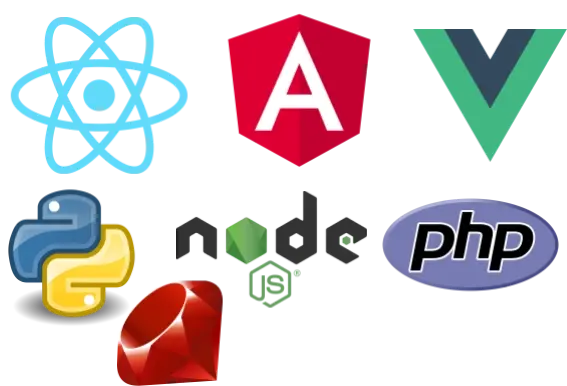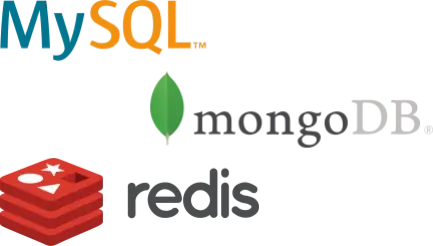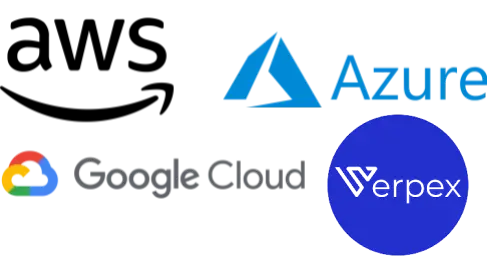In today's digital age, having a website is essential for any business's success. It is the backbone of your online presence and significantly influences your success, acting as a point of contact between your business and potential customers. It's also crucial for your website to be dynamic, especially if it contains data that changes occasionally. In this article, we will delve into how to build a dynamic website. Let's get started.
What is a Dynamic Website?
A dynamic website is a site that generates dynamic pages in real-time based on the interactions of users, their location, their time zone, and their browsing habits. It is a site that's constantly changing in real-time.
These websites are developed using server-side languages like Python, Node.js, Ruby, or PHP, combined with HTML, CSS, and JavaScript. This combination connects to a database, allowing the site to dynamically render data in response to user actions.
How Does a Dynamic Website Work?
To build a dynamic website, a request is sent to the server whenever a user performs an action, such as submitting a form or clicking a button. The server processes this request using a server-side language like PHP, Python, or Node.js. If the action involves data from a database, the server-side script queries the database, retrieves the required data, processes it, and sends an HTTP response back to the client. This response can include real-time data for various features, such as the catalog of an e-commerce site or a user's dashboard. The browser then updates its content to display the dynamic content. So many websites you see today are somewhat dynamic - websites such as blogging platforms, an eCommerce website, and a social media platform are all examples of dynamic websites.
Static vs Dynamic Website
Static and Dynamic websites serve different purposes. Static websites mostly contain fixed content generated using HTML, CSS, and JavaScript. The content of a static website stays mostly the same, and the content will only change if you edit the HTML file. A typical example is a landing page. However, a dynamic website retrieves content in real-time and displays it dynamically to the users using server-side languages like Python or PHP.
A dynamic website requires hosting solutions to support the server-side language and database connection, which means it has a high cost of hosting, unlike static websites, which can be hosted on a basic web server and incur lower costs.
A static website is more secure as there’s less chance of attacks because it does not require server-side scripting or database interaction. The absence of server-side scripting and database connections significantly reduces their vulnerability to attacks such as SQL injection or cross-site scripting (XSS). This makes static websites more secure and easier to maintain from a security standpoint. In contrast, a dynamic website requires server-side scripting and database interaction. They are more susceptible to cyber threats, making additional security measures necessary. These measures are essential to protect against vulnerabilities and ensure the website's and its users' safety.
Planning your Dynamic Website
When planning to build a dynamic website, you have to keep the following in mind:
The Purpose and Objectives of Your Website
You have to identify the primary purpose of your website, whether it's for personal blogging, e-commerce, social networking, etc., because the website's purpose will guide you on the content, design, and features of your site. After that, you clearly state what you want to achieve with the website: to increase sales, build a community, or promote a cause. Setting goals will help you track your website's success.
Identify your Target Audience and Their Needs
Determine your target audience by considering their interests, needs, and location, and Identify their needs so your website can address them. Your website features should provide value and solutions to their needs. Prioritize user experience with responsive design, making it accessible and available for mobile devices. You can also implement feedback mechanisms and leverage analytics to stay updated with user behavior. Finally, continually test your website to ensure it provides the desired experience for your users.
Choose an Appropriate Domain Name
The domain name you choose must reflect the purpose of your website. It has to be relevant to your brand's product or niche. The domain name must also be memorable to make it easier for users to find and remember your site. Use a suitable domain extension (e.g., .com, .org, .net) based on your website's target audience. Ensure you thoroughly check trademarks to avoid trouble with the law. For potential SEO advantages, include relevant keywords; however, a user-friendly and brand-compliant domain should always come first. To prevent brand infringement, secure domain variations, and consider the long-term scalability of your selected name to keep your online identity constant, review and renew your domain registration regularly.
Select a Reliable Web Hosting Provider
When choosing a web hosting provider, consider choosing a hosting plan to accommodate your current user needs and future expansion. Verpex is an example of a hosting provider you can utilize for a dynamic website. It would help if you also considered the hosting plan's security, backup options, and cost.
Developing your Dynamic Website
You must select the technology stack to create a successful website. However, here is a breakdown of the technology stack to select when developing your website.
Technology Stack of Choice
- Programming Language: When selecting a programming language for your project, it’s important to consider various factors such as team expertise, project requirements, and scalability. For the front end, JavaScript programming language is used as it allows you to create dynamic and interactive user interfaces. There are frameworks like React, Angular, and Vue.js to pick from. For the server side, you can choose programming languages like Python and its framework Django, Flask, PHP, Node.js, Ruby, etc.

- Database: The database system is the heart of a website, storing all data. There are two main categories of databases: relational and non-relational. Relational databases, like MariaDB, PostgreSQL, and SQL Server, organize data into structured tables with predefined relationships suitable for well-defined data models like e-commerce platforms and financial systems. Non-relational databases, like MongoDB and Redis, store data in formats like key-value pairs, documents, or wide-column stores, suitable for scenarios where data structure evolves or requires high scalability and quick data retrieval, such as social media platforms, content management systems, and real-time analytics.

- Hosting: Choose a hosting provider that meets your scalability, security, and budget requirements. Think of hosting as a home for your website on the internet. You can choose many hosting providers, including Verpex, AWS, Google Cloud, Azure, etc. Each has its advantages, depending on what your website needs.

Phases Involved in Building a Dynamic Website
Designing the User Interface (UI): Create a wireframe, a basic layout of your website's appearance. After wireframing, create interactive prototypes using tools like Figma and Adobe XD to develop the design by including colors, typography, and images. Ensure you make the design responsive to adapt gracefully to different screen sizes.

Database Design: Design the database by including database tables, relationships, structure, and schemas.
Frontend Development: Convert the user interface design using HTML, CSS, JS, or its framework to code and implement features. Ensure it's user-friendly and responsive in different screen sizes and devices.
Backend Development: Select a backend framework, build the server-side logic API endpoints, and Implement user authentication and authorization. Integrate the API with the frontend components, Conduct thorough tests, which can be unit tests, and identify and fix bugs to ensure all features work as intended.
Security Considerations: To protect the user data, encrypt it in transit and at rest. Follow Security best practices to prevent common vulnerabilities such as Cross-Site Scripting (XSS), Cross-Site Request Forgery (CSRF), and SQL injection. Utilize web application firewalls and intrusion detection systems to monitor and defend against security threats.
Pros and Cons of Dynamic Websites
Pros
Cons
Pros of Dynamic Websites
Better User Experience: Dynamic websites are engaging and can enhance the user experience by adding interactivity.
Real-time Data: Dynamic websites display real-time data such as news updates and engage users.
Ease of Updating: It makes it easier to update the data by using content management tools and systems instead of updating it straight from the files.
Search Engine Optimization (SEO): Dynamic website offers better SEO through dynamic content and user engagement
Cons of Dynamic Websites
Expensive: Dynamic websites have a high cost to develop and maintain due to hosting, development, and maintenance requirements.
Performance: Most dynamic websites experience slow loading time, especially under high server loads.
Security: It's likely for dynamic websites to be vulnerable to Security threats like SQL injection and require robust security measures.
Complexity: Maintaining a dynamic website is more complex due to server-side database, scripting, and real-time functionality
Types of Dynamic Websites
Here are some examples of some popular dynamic websites:
Amazon: Personalizes product recommendations and prices based on user browsing and purchase history.
Google: Tailors search results and ads according to user search patterns, location, and preferences.
Netflix: Customizes movie and TV show suggestions based on individual viewing history and preferences.
New York Times: Updates news content and article recommendations based on current events, reader interests, and browsing history.

Conclusion
This article covered the step-by-step process of creating a dynamic website, utilizing technologies like HTML, CSS, JS, server-side scripts like Python, Nodejs, or PHP, and a database and also outlined the advantages of a dynamic website, their tech stacks, and real-world examples of a dynamic website.
Dynamic websites offer interactivity and personalization that static sites can't match. They engage users more deeply, adapt to their needs, and create a more memorable and satisfying experience. It will help if you consider making your next website dynamic, as it will enhance your online presence and give your users a great experience when they visit your website.
Frequently Asked Questions
Are website builders easy to use?
One of the easiest ways to build a website is with a website builder. Using a website builder doesn't require any programming and coding skills.
Can I afford a website builder?
Yes. Besides paid website builders, there are also free ones; however, they come with fewer options.
Is a website on WordPress safe?
Websites on WordPress are safe, however to avoid hacking keep your website up to date.
Why should I create a website?
There are many reasons why you should create a website if you’re an artist. You can use it to create a place where people can learn about you, talk about your art, or show off your work.

Gift Egwuenu is a developer and content creator based in the Netherlands, She has worked in tech for over 4 years with experience in web development. Her work and focus are on helping people navigate the tech industry by sharing her work and experience in web development, career advice, and developer lifestyle videos.
View all posts by Gift Egwuenu




















